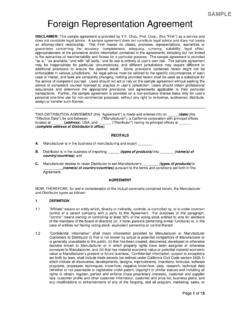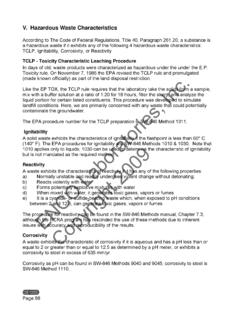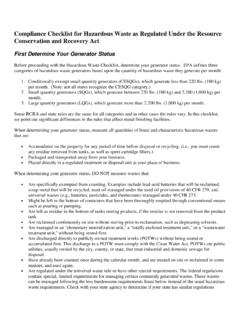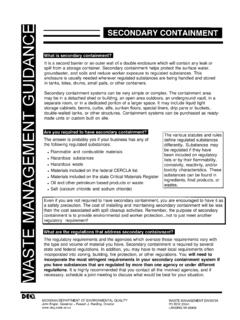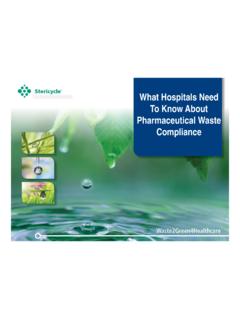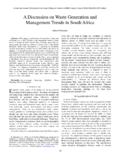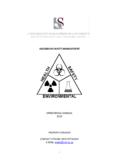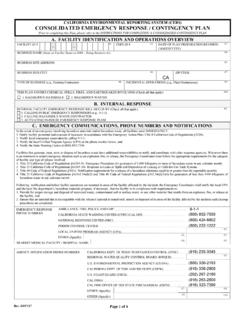Transcription of Satellite Accumulation - Tree Fruit Research & Extension ...
1 hazardous waste and Reduce waste Toxics Reduction Program Satellite Accumulation Technical Information Memorandum Publication #94-120, Revised January 2003 he purpose of this Technical Information Memorandum (TIM) is to provide guidance and interpretation on the Department of Ecology s (Ecology) Satellite Accumulation regulations. This document does not replace the state or federal regulations dealing with the proper management of dangerous ( hazardous ) waste . Please refer to Chapter 173-303 Washington Administrative Code, and federal 40 CFR regulations for complete definitions and regulatory citations. Problem Statement All types of dangerous waste storage are regulated. The standards for storing and accumulating dangerous waste vary depending on the following three items: 1. length of time, 2. location, and 3. volume of waste being stored or accumulated. The Satellite Accumulation provisions outlined in the Dangerous waste Regulations, Chapter 173-303 WAC, have been difficult to interpret for both inspectors and the regulated communities.
2 Since dangerous waste Accumulation is commonly practiced, Ecology prepared this document to clarify the elements of Satellite Accumulation . Satellite Accumulation Area Defined Satellite Accumulation Area is defined as a location at or near any point of generation where dangerous waste is initially accumulated in containers before consolidating the waste at a designated Accumulation area (90/180-day) or storage area. The term Satellite Accumulation area is not found in the federal Resource Conservation and Recovery Act (RCRA) regulations, 40 CFR. However, because the term is widely used, a definition was added to the Dangerous waste Regulations. Refer to WAC 173-303-040. It is important to note that accumulating waste in containers must occur during routine operations. And, the area must be under the control of the process operator where the waste is being generated or secured at all times to prevent improper wastes from being added to the Satellite containers.
3 Satellite Accumulation Provisions The following is a list of provisions for maintaining Satellite Accumulation areas: A generator may accumulate as much as 55 gallons of dangerous waste or one quart of acutely hazardous waste , per waste stream in containers at or near any point of generation (see Satellite Accumulation Area Defined). The Satellite area must be under the control of the process operator where the waste is being generated; or the area must be secured at all times. The generator must be able to prevent improper wastes from being added to the Satellite container. Satellite Accumulation is allowed without a storage permit provided the generator complies with the following sections of WAC 173-303: Container labeling/marking requirements, -200(l)(d) Condition of containers, -630(2) Compatibility of waste with containers, -630(4) Containers to be closed, -630(5)(a) Container handling to prevent leaks, -630(5)(b) T 2 Special requirements for ignitable or reactive wastes, -630(8)(a), and Special requirements for incompatible wastes, -630(9)(a) and (b) When 55 gallons of dangerous waste or one quart of acutely hazardous waste is accumulated per waste stream, the container(s) must be marked immediately with the Accumulation date.
4 The waste must then be moved within three days to a designated storage or Accumulation area. On a case-by-case basis Ecology may require the Satellite area to be managed in accordance with all or some of the 90/180 day Accumulation standards, (WAC 173-303-200(2)). Ecology may require this if the nature of the wastes being accumulated, a history of spills or releases from accumulated containers, or other factors are determined to be a threat or potential threat to human health or the environment: WAC 173-303-200(2). Problem Resolution Ecology recognizes the various operational and waste management constraints that occur from site to site. Therefore, the Satellite Accumulation provisions were developed to provide flexibility for both the generator and inspector implementing waste management activities. The regulations governing Satellite Accumulation apply to all generators subject to WAC 173-303-200.
5 The advantage of the Satellite Accumulation regulations is that they allow generators, who comply with these regulations, to accumulate dangerous waste on-site without obtaining a dangerous waste storage permit. Otherwise, the generator and the waste collecting in Satellite Accumulation areas are subject to all other applicable dangerous waste regulations. Conditionally exempt small quantity generators (SQGs) are exempt from Section 200 if they comply with their own subset of regulations outlined in the Dangerous waste Regulations, (refer to WAC 173-303-070(8)). This TIM addresses and clarifies implementation and compliance related issues associated with Satellite Accumulation . Number of Satellite Accumulation Areas Allowed On-site A generator is not limited to the number of Satellite Accumulation areas allowed on-site. Each waste stream is entitled to be accumulated under the Satellite Accumulation provisions and to its own Satellite Accumulation area.
6 Per or Each waste stream Per or each waste stream refers to individual waste streams, each with an individual point of generation. Individual waste streams include: wastes that are physically or chemically different from each other; wastes that are generated from different types of processes; and wastes that are the same type, but are generated at different points along the same process or at different process locations. Volume Threshold Limit Each Satellite Accumulation area is limited by volume, up to either 55 gallons of dangerous waste or one quart of acutely hazardous waste . Number of waste streams at each Satellite Accumulation Area Each Satellite Accumulation area is limited to an individual waste stream. A generator may accumulate up to 55 gallons of one dangerous waste or one quart of acutely hazardous waste waste stream in a single Satellite Accumulation area. However, since the rule does not specify a minimum distance between Satellite Accumulation areas, two or more separate areas may be adjacent to each other.
7 Distance Between Satellite Accumulation Areas A minimum distance requirement for two separate Satellite Accumulation areas is not outlined in the regulations. A generator may have two or more separate Satellite 3 Accumulation areas immediately adjacent to each other provided each area independently meets the definition and requirements for Satellite Accumulation . Number of Containers at Each Satellite Accumulation Areas A generator is not limited to the number of containers allowed in a Satellite Accumulation area to collect waste . The important point is that each area does not exceed the volume threshold limit as mentioned above. Container Requirement Satellite Accumulation is limited only to containers. Satellite Accumulation activities occurring in tanks, waste piles, lagoons, or another dangerous waste management unit or device is prohibited. A container is any portable device in which a material is stored, transported, treated, disposed of, or otherwise handled: WAC 173-303-040.
8 At or Near the Point of Generation There is no maximum or minimum distance used to define or interpret at or near the point of generation. Since there are numerous processes where dangerous wastes are generated, a specific distance requirement, such as 10 feet between the point of generation and the Satellite area, would limit the ability of a generator and inspector to effectively and safely manage dangerous waste . This element of Satellite Accumulation provides flexibility in applying and using the rule. At or linear is intended to be used as its common, everyday meaning. Satellite Accumulation in 90/180 Day Accumulation Areas The Satellite Accumulation regulations do not prohibit a generator from locating a Satellite Accumulation area within a 90/180 day Accumulation area. The areas located as such, must independently meet the definition of Satellite Accumulation area and be in compliance with the Satellite Accumulation regulations.
9 Off-Site Locations Satellite Accumulation areas cannot be located off the site where the waste is initially generated. Any dangerous waste shipped off-site by large or medium quantity generators must be sent to a designated facility listed on the manifest. Dangerous waste shipped off-site by small quantity generators is also limited to where it can be sent (refer to WAC 173-303-070(8)). In any case, waste cannot be sent away from where it was initially generated or to a separate location (off-site) under the provisions of Satellite Accumulation . Operator Control or Secured Satellite Accumulation areas must be either under the control of the operator of the process generating the waste or secured at all times. The intent of providing both options in this rule is to allow flexibility in locating a Satellite Accumulation area and to prevent the improper or unauthorized addition of waste to a Satellite Accumulation container.
10 Operator of the Process Generating waste The operator of the process generating waste means any person at the production level who is responsible for operating, or coordinating the operation of, manufacturing process or any other process which generates a waste . The operator may include several individuals in cases where the facility has two or three shifts with a different process operator during each shift. If an operator can assure a second party, not involved in the generation of the waste , that he can secure the Satellite Accumulation area to prevent improper additions of waste into the Satellite container then the intent of the Satellite regulations would be met. Secured at All Times The secured at all times option allows a Satellite Accumulation area to be located in one location although a waste stream, such as 4 batteries and rags, may be generated throughout a facility.





